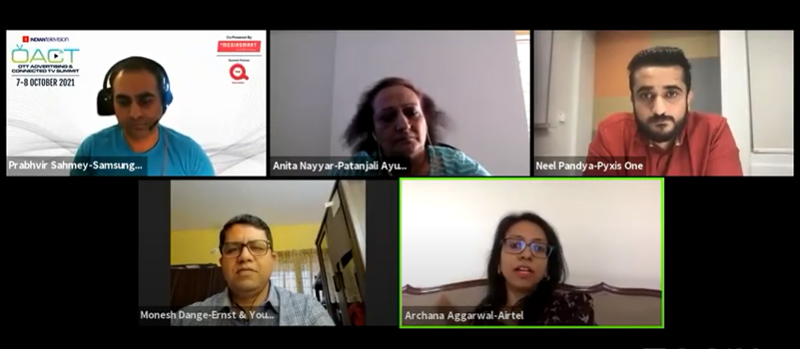Mumbai: Is it the right time for monetisation of OTT from a business perspective for advertisers?
This set the ball rolling for the panel discussion on – ‘The opportunities for OTT and CTV Advertising’ on the first day of the OTT Advertising and Connected TV Summit being organised by Indiantelevision.com. The two-day event is co-powered by mediasmart, an Affle company and summit partner – The Q.
The panel was led by Patanjali Ayurved COO-media and communications Anita Nayyar, Airtel VP-media Archana Aggarwal, Pyxis One CEO- APAC Neel Pandya, Samsung Ads India & South East Asia – senior director Prabhvir Sahmey and moderated by EY partner and national leader - advisory markets Monesh Dange.
Responding to the question, Nayyar highlighted that the time is perfect for monetisation for OTT platforms, as the content has never been more important than now in the pre-, post-, and during the Covid-19 time. “For advertisers, ROI is very important. The clichéd conversion will always stay as it is. But as of now, the industry is at an evolving stage that is clearly a top of funnel scenario with reach, awareness, engagement -all that’s happening. But whether we can attribute that directly to a bottom-funnel is not very clear at this point of time,” she added.
On whether the digital boom in content was bound to happen or it happened due to the time available on hand due to the Covid-19 era, Airtel’s Archana Aggarwal noted that the start of the revolution was with the crash in data prices and affordability of smartphones and people using a lot of mobile internet. “Obviously, Covid accelerated it due to the dearth of new content on linear Television and no new movies being released in theatres, etc. But it was a matter of time that people would start consuming a lot of content on OTT,” she said.

Talking about how majority of the premium content available on OTTs is behind the paywall, Aggarwal said, “What is it that the OTTs want to monetise- Do they want to monetise through advertisements or through subscription? That is something which OTT players need to think through – how to find the right balance between the two.”
Neel Pandya of Pyxis One added another insight on the OTT boom by commenting that it takes just twenty-one days for a person to build a habit and they were talking about 1.5 years of watching digital content. “So it’s a very strong habit which consumers have built and it's not going to go easily,” said Pandya. “Obviously it's not an artificial boom completely, but it has gone 5X from what the acceleration would have been in normal circumstances.”
From Samsung Ads’ perspective, Prabhvir Sahmey said, “We are relatively a new business and also a unique proposition where we are bringing the advertising opportunity directly on the device itself, it's not running on the back of a content.”
He added, “It’s still at a very nascent stage, in fact we are in a testing category. We will try to plug the gap in measurability, and develop a multi-device solution for advertisers.”
Taking the discussion further, Pandya said it is high time that OTT as a platform starts attracting ad spends, attracting avenues. “It is growing globally really fast. The only new thing we need to attract new users is measurement. OTT needs to bring more customised solutions for brands and take some bold decisions,” he added.
Nayyar shared insights on the current dynamics of OTT and how it is similar to what happened a couple of decades back on television from one Doordarshan to multiple TV channels when the satellite boom materialised. “So it is important for OTT players to put some skin in the game collectively as an industry with accountability and measurement if they want to scale up monetisation,” she added.
Talking about Patanjali and its investment in OTT, Nayyar said that Patanjali is working to upgrade the brand and make it more premium by targeting the youth. “OTT is a very important medium to influence youth. The first deal we went with was Dance Plus on Disney Hotstar,” she added.
While Airtel has been advertising on OTT as well as connected TV for a long time now, and have been experimenting with it. “We are looking at on-target reach & duplication of audience. It’s important for us to look at what kind of audience the platforms are giving us. We have evolved from being broad-based to being more targeted, focused on a set of audiences,” shared Aggarwal.
Transparency, when it comes to the results of the campaign, is a very critical factor, was agreed by everyone.
Prabhvir Sahmey of Samsung Ads said the elephant in the room for every publisher is revenue ad risk and that has to be addressed. “Everybody knows there is significant overlap at the end-user behavior,” he added.
With acceleration to OTTs, the question of whether television is going to disappear was met with a unanimous ‘No.' The panelists agreed that TV as a screen or as a medium is not going anywhere. At the most, it may evolve to connected TVs, rather than remain as a device of one-way linear transmission.
For more information: https://indiantelevision.com/events/oact-summit-2021/






